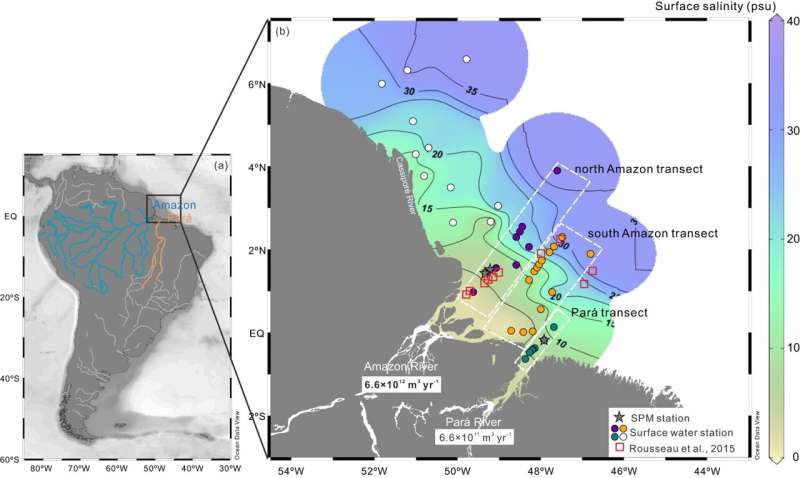
The Amazon River is the largest river in the world. It discharges about one fifth of global freshwater runoff, resulting in a freshwater plume rich in nutrients and trace elements entering the Atlantic Ocean.
Until now, it was assumed that the suspended solids partially dissolve in the water plume of the estuary and thus represent an important source of trace metals, but the latest results refute this theory. Isotopes of the elements neodymium (Nd) and hafnium (Hf) were examined. These can serve as tracers or origin, i.e. their analysis can be used to determine where water masses come from. Each river has its own isotopic signature that represents the source rock in the hinterland.
“A previous study had found an increase in the dissolved concentration and variability of neodymium isotopes in the Amazon estuary and concluded that these are dissolved from particles carried by the river on its way to the open ocean,” says the study’s first author Antao Xu.
He is a Ph.D. student in the Chemical Paleoceanography group headed by Professor Dr. Martin Frank at GEOMAR Helmholtz Centre for Ocean Research Kiel, who was co-chief scientist of the METEOR expedition M147 (official GEOTRACES process study GApr11) in the Amazon estuary (chief scientist was Prof. Dr. Andrea Koschinsky, Constructor University Bremen).
“We have now disproved this conclusion,” says Martin Frank. “We can show that the changes in isotope composition are a result of the admixture of freshwater from the nearby Pará River.”
The input of the neighboring Pará River south of the Amazon mouth shows significantly elevated dissolved neodymium and hafnium concentrations. At the same time, it has a low pH value. This led to another important finding. Co-author Ed Hathorne says, “We looked at the relationship between neodymium concentration and pH in rivers around the world.”
It turned out that neodymium concentration can be directly inferred from pH. This allowed a revised estimate of the global dissolved riverine neodymium flux, which is at least three times higher than previously thought, according to co-author Georgi Laukert of Dalhousie University, Halifax, Canada and the Woods Hole Oceanographic Institution, Woods Hole, U.S..
The study is part of the international long-term project GEOTRACES, which aims to map the global distribution of trace metals dissolved in seawater and their isotopes in order to gain a better understanding of their sources, sinks and distribution pathways. As paleo-oceanographer, Martin Frank and his working group are actually interested in trace metals in their function as indicators of past climate history and ocean processes.
“The isotopic composition serves us as a proxy for the ocean circulation of the past,” says Frank. “However, we still need a better understanding of the controlling processes in today’s ocean to be able to apply these proxies more reliably.” This is in line with the transdisciplinary approach of integrating research at GEOMAR, for which “metals in the ocean” is a thematic focus.
Frank says, “In order to be able to develop reliable models for the entire ocean-atmosphere-climate system, we need to better understand the global ocean circulation and the distribution of trace metals coupled to it, for which we need to know the inputs of trace elements from land.”
GEOTRACES is a global program which aims to improve the understanding of biogeochemical cycles of trace elements and their isotopes in the marine environment. Much of what is known about ocean conditions in the past and, therefore, about the ocean’s role in climate variability, is derived from trace element and isotope patterns recorded in marine archives (sediments, corals, etc.).
Improved knowledge of the processes governing the distribution these tracers in the modern ocean can improve our understanding of past ocean conditions recorded by marine archives, based on which predictions of future changes can be made more reliably.
The work is published in the journal Nature Communications.
More information:
Antao Xu et al, Overlooked riverine contributions of dissolved neodymium and hafnium to the Amazon estuary and oceans, Nature Communications (2023). DOI: 10.1038/s41467-023-39922-3
Provided by
Helmholtz Association of German Research Centres
Citation:
Rio Pará found to contribute high trace metal concentrations to the Amazon estuary (2023, July 31)
retrieved 31 July 2023
from https://phys.org/news/2023-07-rio-par-contribute-high-metal.html
This document is subject to copyright. Apart from any fair dealing for the purpose of private study or research, no
part may be reproduced without the written permission. The content is provided for information purposes only.


